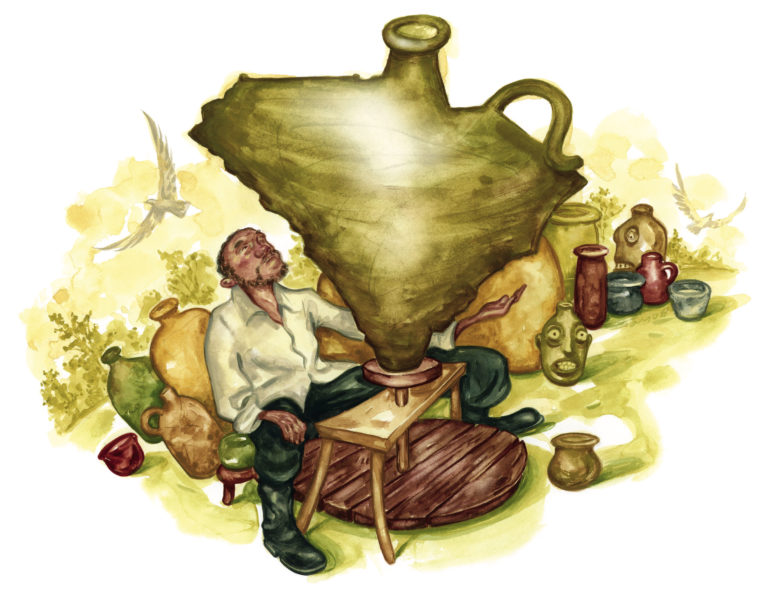All ’Cued Up
Ribbons of meat-scented smoke draw crowds who come for flame-crisped links of Alabama-made Monroe smoked sausage, shreds of tender pulled pork soaked in sweet, subtly spicy tomato-based sauce, and ribs slicked in the same, all alongside silken collards, cornbread planks, and gooey mac and cheese. At the Hog Days of Summer in Montgomery (August 27), pitmasters and cooks from area restaurants gather to throw the tastiest party of the year. A group of childhood buddies host Hog Days in honor of a friend who died of cancer, and its proceeds help area families struggling with the staggering costs of treating pediatric brain cancer. At downtown’s historic Union Station Train Shed, the James Beard Award–winning New Orleans chef Ryan Prewitt (who married a Montgomery gal) serves chicken thighs smothered in Alabama white sauce, and from a mobile pit, Hill Lubin, co-owner of Moe’s Original BBQ, makes dry-rubbed St. Louis–style ribs. James Bethune, pitmaster at Brenda’s Bar-B-Que Pit, Montgomery’s oldest barbecue joint, would rather transport finished food than feel the burn on-site—he smokes his ribs and chickens at Brenda’s and then hand delivers them. “Our pit is seasoned by the eighty years we’ve been here,” he says. “That adds a taste that can’t be duplicated.” hogdays.org
Still Cooking
In 1922, Skyline Cafe opened in the tiny railroad town of Mena, in the foothills of the Ouachita Mountains along the Talimena National Scenic Byway in western Arkansas. The radio comedians who played the lovable hillbillies Lum and Abner were patrons in the 1940s, and this year the café marks a hundred years of small-town camaraderie. “It’s always been a local hangout,” says Candon Burrell, the owner since 2002. “Regulars are in here starting wars or settling feuds over coffee every morning.” Burrell plastered the walls with historical photos of Mena, and as the chief cook, she cranks out breakfast all day, keeps the salad bar stocked with veggies and deviled eggs, and slices corned beef for a locals’ favorite hash. At the peak of summer, neighbors bring Burrell whatever’s fresh from their gardens, and she fries okra, mixes her signature salsa, and slices tomatoes for sandwiches that taste like the best of both the past and the present. facebook.com/skylinemena

Strike It Rich
The epic fall runs of migrating mullet turn Florida’s east-central coast into a cage match for anglers. All through September, the mullet come in waves, and waiting for the free-for-all are tarpon, snook, redfish, bluefish, and ladyfish, plus blacktip and spinner sharks in huge numbers. “It’s a hell of a thing to see,” says Captain Eric T. Davis of Vero BackCountry Fishing. “Besides the fishery itself, just the visuals are spectacular. You’re trying to get your fly or lure in there among thousands of mullet in a way that says, come get me, come get me.” Davis chases the runs from Sebastian Inlet south to Stuart. When a hard cold front moves through the Carolinas, pushing the mullet down the Atlantic, anglers should follow suit and get to Florida in double time. verobackcountryfishing.com
Evergreen Attraction
“When I entered the forest for the first time, I felt like I had traveled back three or four hundred years,” says the Virginia-raised artist Kristin Leachman, whose exhibition Longleaf Lines opened July 23 and runs through early 2023 at the Georgia Museum of Art, in Athens. In 2020, she visited a Southwest Georgia old-growth longleaf pine forest, researching the ancient trees as part of her ongoing state-by-state project Fifty Forests. Longleaf pine forest once covered some ninety million acres from Texas to Virginia and was—and is—home to a biodiversity of species that rivals that of rain forests, including gopher tortoises, indigo snakes, bobwhite quail, and red-cockaded woodpeckers. After covering panels with shades of red, Leachman painted studies of the trees, focusing on the undulating bark patterns and the burn marks that attest to fire’s historic role in maintaining the health of the forest. georgiamuseum.org

A Walk in the Park
Lauded as the father of landscape architecture, Frederick Law Olmsted left his green thumbprint all over the country. While Manhattan’s Central Park, the Biltmore estate in Asheville, and Stanford University’s campus in California may be his most famous designs, one of his most extensive works can be found in Louisville, where seventeen public parks make up the Olmsted Park System. “Olmsted shaped the city—quite literally,” says Layla George, president of the city’s Olmsted Parks Conservancy. He strategically placed the three flagship parks beyond the urban core—Cherokee to the east, Iroquois to the south, and Shawnee tucked alongside the Ohio River to the west—and the city grew out toward them. This year, spaces designed by Olmsted around the country are celebrating the two hundredth anniversary of the architect’s birth, and Louisville will see the groundbreaking of a twenty-five-acre enlargement of Cherokee Park—the first major expansion since the system’s founding in 1891. olmstedparks.org
Some Like it Sweet
Right around Labor Day (September 5), some seven thousand acres of Louisiana sweet potatoes will become ripe for the digging in the northeastern part of the state. Since 1948, Louisiana State University’s agricultural program has run its own dedicated sweet potato research station, which crossed heirlooms to create today’s most popular varieties: Beauregard, Orleans, Bayou Belle, and extra-sweet Evangeline, the personal favorite of René Simon, the director of the Louisiana Sweet Potato Commission. “I eat them baked plain, no sugar, no cinnamon, skin and all,” he says. But any Louisiana sweet potato, he adds, plays well in a crawfish boil to sweeten the pot and cut through the spice. Simon recommends one small sweet potato per crawfish eater, with a few extra thrown in for good measure. sweetpotato.org
Days on the Bay
In September 2020, Chris Hopkinson became the first person to stand-up paddleboard down the entire length of Chesapeake Bay. The 207-mile journey took him just nine days, after which he turned that feat into an annual event. Now he’s preparing for the third Chesapeake Bay Paddle, when over five days in August, paddlers with all vessel varieties and skill levels will take to the water to raise money for the Oyster Recovery Partnership, Chesapeake Conservancy, and Waterkeepers Chesapeake—organizations that restore, preserve, and protect the bay. Participants will begin their endurance challenge in Rock Hall, Maryland, and paddle along the shorelines of historic towns until they reach Cape Charles, Virginia. “Being on the water changes your perspective,” Hopkinson says. “You learn to appreciate how beautiful it is and how important it is to clean it up and preserve it for future generations.” baypaddle.org
Ships Ahoy
Halfway along the eleven-mile cruise between Gulfport and Ship Island, one of four Mississippi barrier islands, most passengers lose cell phone service. “And that’s a good thing, because then you can really connect with the park,” says Kevin Buckel, who works at Ship Island Excursions, the family-owned business that has ferried visitors along what’s now Gulf Islands National Seashore since 1926. After a year out of service due to hurricane damage, the ferries (which can carry three hundred passengers) are back up and running, shuttling beachgoers to the island twice a day and for dolphin-searching and weekend sunset tours. On the remote seven-mile-long island, bird-watchers might spot migratory magnificent frigate birds, reddish egrets, and black terns, and circa-1858 Fort Massachusetts casts shade for shell hunters. msshipisland.com
Aim to Please
“It used to be that you handed the woman the spa brochure and the man the fishing and shooting brochure when couples came to the lodge,” says Morgan Tarbutton, Chetola Resort’s outdoor director. But those stereotypes just don’t fit anymore—especially at Chetola, a seventy-eight-acre resort surrounded by the rugged Blue Ridge Mountains in Blowing Rock. Tarbutton, a shooting instructor, began managing Chetola’s outdoor programs in 2014 (she was also one of only a handful of female fly-fishing guides at the time). Today she and her fly-fishing-guide husband, Dustin Coffey, lead river excursions that meander into Tennessee from the first of only two Orvis-endorsed lodges in North Carolina, and the preserve offers a twenty-acre sporting clays course, a five-stand clay station, and an archery range surrounded by regal oaks. chetola.com

History by Hand
Beneath the rim, a handwritten notation: “when you fill this Jar with pork or beef / Scot will be there; to get a peace, - / Dave.” In a literal sense, the poem doubles as instructions for how to use the alkaline-glazed container, but when David Drake, an enslaved potter in Edgefield, South Carolina, inscribed it on the storage jar in April 1858, it was an act of defiance. Anti-literacy laws forbade both enslaved and free people of color to learn to read or write. Drake’s jar is part of Hear Me Now, a powerful exhibition on Edgefield pottery at the Metropolitan Museum of Art in New York City (opening September 9). “Edgefield stoneware is known regionally, but this project will present these objects—and the history and makers behind the stoneware—to new audiences,” says Adrienne Spinozzi, one of the curators of the more than fifty objects on display, many of them never seen before outside the South. Drake’s nineteenth-century masterwork sits on view beside vessels by lesser-known—or still-unknown—artists who also demonstrated their literacy, bravery, and adeptness at the potter’s wheel. “Face jugs,” or vessels styled with grimacing expressions, are unmissable, including the mid-nineteenth-century pot treasured by Mamie Deveaux, an African American fortune-teller who practiced in Savannah. Works by modern-day artists including Simone Leigh and Robert Pruitt sit in discourse with the historical objects, “exploring this rich and complicated history,” Spinozzi says. “They’re literally reshaping the conversation about Edgefield stoneware.” metmuseum.org
Lofty Living
When Amanda Jensen and her husband, Brian, built a tree house for their children years ago, they decked it out with a zip line, foldout bunk beds, and a fire pole. That wonderland sparked their current endeavor to construct the adult-and-kid-friendly Sanctuary Treehouse Resort in the mountains of East Tennessee. “There’s something about staying in a tree house that takes us all back to childhood,” Jensen says. Late this summer, their sylvan success story will tower outside Knoxville on a forty-acre spread of sugar maple, pecan, and black walnut trees, when the first six of a planned 140 treehouses will open for reservations. “The beds are hanging from ropes, and there are outdoor daybeds, slides, and sinks made of whiskey barrels,” Jensen says of the rustic digs. Guests can chug around the resort in solar-powered golf carts—no cars allowed—and catch panoramic mountain views from quite a perch. treehouseresort.com

Comeback Kids
“They look like souped-up toads, but they are actually lizards,” says Diane Barber, the project coordinator of the Texas horned lizard program at the Fort Worth Zoo. The zoo breeds the spiky-headed, short-tailed reptiles, which once roamed the state in abundance but have suffered population hits from habitat loss, invasive fire ants, and pesticide use. Every summer, Barber and her team wait for some four hundred eggs the size of Tic Tacs to hatch so the babies—so small they fit on a human’s pinkie fingernail—can be introduced into Mason Mountain Wildlife Management Area a few hours southwest. Once released in the preserve, the lizards grow, with the zoo’s partner in the effort, Texas Christian University (which claims the horned lizard, also known as the horned frog or horny toad, as its mascot), tracking their progress. “We’re figuring out how to establish a population, and in the future, we’ll expand and introduce at other sites,” Barber says. “They’re little tanks, and they are capable of adapting.” fortworthzoo.org
Time and Time Again
When Colonial Williamsburg calls itself a living history museum, it’s referring to more than just the gunsmiths, milliners, and George Washington impersonators ambling along the cobblestoned streets. Through ever-progressing research, documentary analysis, and archaeological digs, sometimes the buildings themselves evolve or even revert to a former incarnation. “Since the restoration of Williamsburg began in the 1920s, we’ve developed so many more capabilities,” says Dani Jaworski, the manager of architectural collections. Those capabilities have led to some major architectural discoveries, spotlighted in the new exhibit at the Art Museums of Colonial Williamsburg called Restoring Williamsburg (through 2024). For instance, an overmantel landscape painting found in the George Reid House prompted historians to dig further, uncovering that a blacksmith and his wife lived there during the American Revolution, before the merchant the home was named for. A 1773 Virginia Gazette advertisement mentioned a porch on the front of the Raleigh Tavern, which facilities staff then added back in 2017, confirming that Southerners’ love for porches transcends the centuries. colonialwilliamsburg.org
Do the Locomotive
The Durbin & Greenbrier Valley Railroad’s tracks carry pleasure riders into the past. Old-school Shay, Climax, and Heisler locomotives pull a mix of vintage and refurbished passenger cars along a twentieth-century logging route and the Greenbrier River in Pocahontas County, where you might spot bald eagles, otters, turkeys, and black bears (leaf-peeping tours run through October 30). “Taking a scenic train trip seems to bring people closer to nature in a different manner than travel in the family car,” says John W. Smith, the railroad’s president. “We don’t really go very far or very fast, but the ride just seems to settle your nerves and soothe your soul.” mountainrailwv.com


